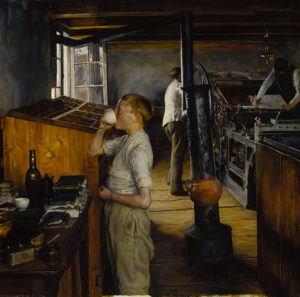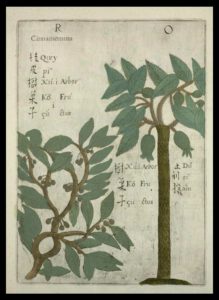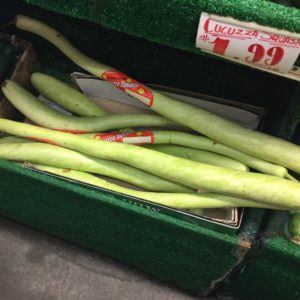WAYZGOOSE is a fun word that gets tossed around a lot in printing circles, usually marking a big celebration involving presses. But the word, beautifully obscure as it is, does have one particular day associated with it: St. Bartholomew’s Day, the 24th of August… also known as St. Bartlemy’s Day, or Bartlemas. St. Bartholomew is one of the patron saints of bookbinders. Indeed, of most anyone associated with the book, so he has become a patron saint of book artists, in general. I may be a writer, but I come to words through the book arts, so these are my people: we are papermakers, book designers, printers, and bookbinders, and St. Bart watches over all of us and our crafts.
We know very little about Bartholomew the man. He was one of the Twelve Disciples; that much we do know. He may have traveled to India, to the area around Bombay. Tradition says that he met his end in Armenia in the first century; he is one of the legion of saints who met gruesome deaths for their beliefs, and his was about as gruesome as it gets. You may want to skip the next sentence if you don’t want to read about it…. Here goes: St. Bart was flayed alive, and as if that wasn’t harsh enough, he was then crucified upside down. If you skipped that sentence, it’ll make no sense, really, why he is patron saint of bookbinders, so go on, go back and read it. Done? Okay, good. That flaying made St. Bartholomew a patron saint of butchers (and there were many in my family, for generations back in Italy on my dad’s side) and of tanners… and of bookbinders, who very often bind books in leather. (It all makes sense now, doesn’t it?)
Then there are the papermakers, whose Bartlemas traditions have more to do with the subtle daily shifting from summer to winter. While the bookbinders were honoring St. Bartholomew with their leather bindings, the papermakers were marking St. Bart’s Day in an “out with the old, in with the new” fashion, using up the last of their summer pulp in the vats by making paper not for the print shops but rather for folks to use to seal off their windows for the coming winter. Glass windows came into vogue much later; earlier on, it was waxed paper that was used to keep out the elements. Once this St. Bart’s window paper was made, the papermakers went back to making paper for the printers, clearing out the vats and recharging them with new pulp made from rags that had been retting all summer long.
And finally, the printers. The printers are the life of the Bookish Bartlemas party, for it is the printers who celebrate the Wayzgoose, a particularly English custom with a direct link to the waning summer. All summer long, they’d been setting type by sunlight. But come St. Bartholomew’s Day, that sunlight was fast decreasing; we are, after all, a full two months now past Midsummer. That longest day each June is followed always by increasingly shorter days, increasingly longer nights, as we proceed on that annual trek toward Midwinter. The Bartlemas Wayzgoose came about as a marker of days: It was the day each year when printers typically returned lamps and candles to the print shop, when they began again to set type with the aid of lamps. A good print shop proprietor would bring in not just the lanterns and candles, but some good food and strong ale to boot. His crew might get the day off and a little extra pay, as well, which was typically spent on a goose to roast for the table (which is one theory of the source of the word “Wayzgoose”). In some places, mead, the delightful intoxicating beverage made from honey, was the beverage of choice. Especially in Cornwall, where a Blessing of the Mead ceremony takes place even today at this time of year. Continuing the road of connexions, our friend Bart is also a patron saint of beekeepers. As we continue to gather our stores for the coming winter, it is traditional, too, to bring in the honey crop on his feast day.
It’s a couple of years ago now that I first read that the Jerusalem Post, on August 27, 2010, reported that Johannes Gutenberg’s 42-Line Bible, the first book printed from moveable type, was completed on St. Bartholomew’s Day in 1454. I’ve tried finding other sources to back up this claim, but I have to date had no luck. Still, I like the idea of this and if it is indeed true, this may have something to do with the day becoming a matter of such importance to printers and bookbinders. No matter what is fact and what is legend, our view on the day is simple: Bartlemas is a day for celebrating the core traditions of the book arts: papermaking, printing, and bookbinding. If you are a maker involved in these noble arts, as we are here at Convivio Bookworks, perhaps you’ll mark the day by making something suitably bookish. And if you are not a maker but a book arts enthusiast, your job today is to appreciate a good book. Perhaps you are preparing a traditional Rare Bartlemas Beef for your supper tonight, heady with nutmeg, ginger, mace, cinnamon, and cloves. And perhaps your Bartlemas is simply an excuse to pour some ale or mead. No matter your role or how you celebrate, we wish you a Happy Bartlemas, and a Happy Wayzgoose. If there ever is a day in the round of the year for bookish folks to shout Huzzah and cheers!… well, this is it.
Image: “Typesetter at Enschede Haarlem” by Charles Frederick Ulrich. Oil on panel. 1884 [Public domain] via Wikimedia Commons. Perhaps it’s Bartlemas Day? Perhaps there’s mead in that cup? The lamp’s not lit but the windows are open.


